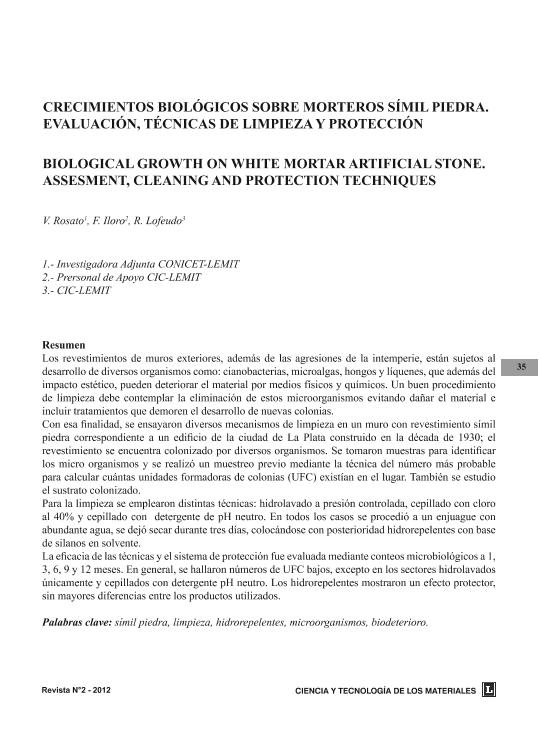Mostrar el registro sencillo del ítem
dc.contributor.author
Rosato, Vilma Gabriela

dc.contributor.author
Iloro, Fabian Horacio

dc.contributor.author
Lofeudo, Rosana

dc.date.available
2023-05-19T16:43:35Z
dc.date.issued
2012-08
dc.identifier.citation
Rosato, Vilma Gabriela; Iloro, Fabian Horacio; Lofeudo, Rosana; Crecimientos biológicos sobre morteros símil piedra: Evaluación, técnicas de limpieza y protección; Comisión de Investigaciones Científicas. Laboratorio de Entrenamiento Multidisciplinario para la Investigación Tecnológica; Ciencia y Tecnología de los Materiales; 2; 8-2012; 35-46
dc.identifier.issn
2250-5989
dc.identifier.uri
http://hdl.handle.net/11336/198161
dc.description.abstract
Los revestimientos de muros exteriores, además de las agresiones de la intemperie, están sujetos al desarrollo de diversos organismos como: cianobacterias, microalgas, hongos y líquenes, que además del impacto estético, pueden deteriorar el material por medios físicos y químicos. Un buen procedimiento de limpieza debe contemplar la eliminación de estos microorganismos evitando dañar el material e incluir tratamientos que demoren el desarrollo de nuevas colonias. Con esa finalidad, se ensayaron diversos mecanismos de limpieza en un muro con revestimiento símil piedra correspondiente a un edificio de la ciudad de La Plata construido en la década de 1930; el revestimiento se encuentra colonizado por diversos organismos. Se tomaron muestras para identificar los micro organismos y se realizó un muestreo previo mediante la técnica del número más probable para calcular cuántas unidades formadoras de colonias (UFC). Para la limpieza se emplearon distintas técnicas: hidrolavado a presión controlada, cepillado con cloro al 40% y cepillado con detergente de pH neutro. En todos los casos se procedió a un enjuague con abundante agua, se dejó secar durante tres días, colocándose con posterioridad hidrorepelentes con base de silanos en solvente. La eficacia de las técnicas y el sistema de protección fue evaluada mediante conteos microbiológicos a 1, 3, 6, 9 y 12 meses. En general, se hallaron números de UFC bajos, excepto en los sectores hidrolavados únicamente y cepillados con detergente pH neutro. Los hidrorepelentes mostraron un efecto protector, sin mayores diferencias entre los productos utilizados.
dc.description.abstract
Cement plasters covering exterior walls, besides being exposed to weather conditions, are also subject to the development of organisms like cyanobacteria, microalgae, fungi and lichens, that apart from the aesthetic impact, may deteriorate the material by physical and chemical mechanisms. A good cleaning process must eliminate these microorganisms but avoid damage to the material and include treatments that delay the growth of new colonies. With this aim, different cleaning mechanisms were tested on a wall covered with a stone imitation white mortar colonized by different organisms from a building in La Plata city built in the 1930s, in order to find the best cleaning method that delays for as long as possible the growth of new colonies. Samples were obtained to identify these organisms and a previous sampling using the most probable number technique to calculate how many colony-forming units (CFU) existed in the place. Cleaning was performed in limited sectors, using different techniques: hydrojet washing with controlled pressure, hydrojet washing, brushing with sodium hypochlorite 40% and with one neutral pH detergent. Once the wall was cleaned, it was rinsed with abundant water, allowed to dry during three days and each sector was subdivided in three. In one sector a hydro- repelling agent with a base of sylane in solvent was applied; in other, a product with a base of syloxanes and alcoxisyloxanes in solvents; whereas the third was left without treatment as control. New microbiological counts were performed after 1, 3, 6, 9 y 12 months. In general, low CFU numbers, except the sectors cleaned with hydrojet- washing and brushed with pH neutral detergent, whereas the hydro-repelling agents showed a protective effect, without great differences between the products.
dc.format
application/pdf
dc.language.iso
spa
dc.publisher
Comisión de Investigaciones Científicas. Laboratorio de Entrenamiento Multidisciplinario para la Investigación Tecnológica
dc.rights
info:eu-repo/semantics/openAccess
dc.rights.uri
https://creativecommons.org/licenses/by-nc-sa/2.5/ar/
dc.subject
Símil piedra
dc.subject
Limpieza
dc.subject
Hidrorepelentes
dc.subject
Microorganismos
dc.subject
Biodeterioro
dc.subject.classification
Otras Ingeniería de los Materiales

dc.subject.classification
Ingeniería de los Materiales

dc.subject.classification
INGENIERÍAS Y TECNOLOGÍAS

dc.title
Crecimientos biológicos sobre morteros símil piedra: Evaluación, técnicas de limpieza y protección
dc.title
Biological growth on white mortar artificial stone: Assesment, cleaning and protection techniques
dc.type
info:eu-repo/semantics/article
dc.type
info:ar-repo/semantics/artículo
dc.type
info:eu-repo/semantics/publishedVersion
dc.date.updated
2023-05-09T14:41:23Z
dc.journal.number
2
dc.journal.pagination
35-46
dc.journal.pais
Argentina

dc.journal.ciudad
La Plata
dc.description.fil
Fil: Rosato, Vilma Gabriela. Consejo Nacional de Investigaciones Científicas y Técnicas. Centro Científico Tecnológico Conicet - La Plata; Argentina. Provincia de Buenos Aires. Gobernación. Comisión de Investigaciones Científicas; Argentina
dc.description.fil
Fil: Iloro, Fabian Horacio. Provincia de Buenos Aires. Gobernación. Comisión de Investigaciones Científicas; Argentina
dc.description.fil
Fil: Lofeudo, Rosana. Provincia de Buenos Aires. Gobernación. Comisión de Investigaciones Científicas; Argentina
dc.journal.title
Ciencia y Tecnología de los Materiales
Archivos asociados
